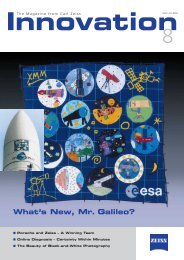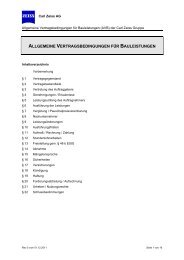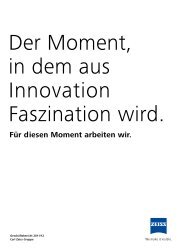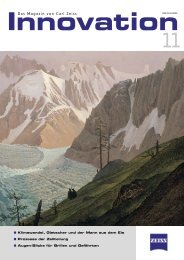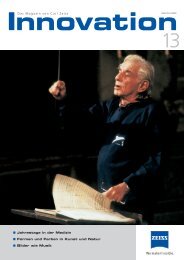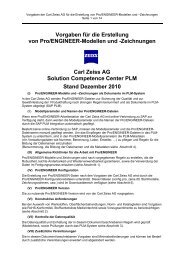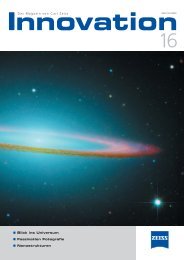Download PDF - Carl Zeiss
Download PDF - Carl Zeiss
Download PDF - Carl Zeiss
Create successful ePaper yourself
Turn your PDF publications into a flip-book with our unique Google optimized e-Paper software.
Objectives<br />
sion lenses, including Bruno Hasert in<br />
Eisenach, Kellner in Wetzlar, G&S<br />
Merz in Munich and Hugo Schroder<br />
in Hamburg. Hartnack’s immersion<br />
lenses, however, were considered the<br />
best.<br />
At the “Exposition Universelle” in<br />
1867 in Paris, Ernst Grundlach (1834-<br />
1908) presented his new glycerin immersion<br />
lens, claiming that he developed<br />
the lens because he wanted to<br />
use an immersion medium with a<br />
higher refractive index than water.<br />
In 1871, Tolles once again presented<br />
something new: he used<br />
Canada balsam as an immersion<br />
medium for homogenous immersion.<br />
His discovery that Canada balsam has<br />
the same refractive index as the<br />
crown glass that was standard at<br />
the time remained unused until Ernst<br />
Abbe discovered a suitable liquid in<br />
1877. The <strong>Zeiss</strong> Optical Works in Jena<br />
also produced initial water immersion<br />
objectives in 1871. In 1872, <strong>Carl</strong><br />
<strong>Zeiss</strong> introduced the Abbe water immersion<br />
objective. Three objectives<br />
Innovation 15, <strong>Carl</strong> <strong>Zeiss</strong> AG, 2005<br />
were offered in the <strong>Zeiss</strong> catalog at<br />
the time, all with an aperture of<br />
180°. They had different working distances,<br />
but also a numerical aperture<br />
of 1.0. Objective no. 3 was equipped<br />
with a correction ring.<br />
In August 1873, Robert Tolles built<br />
a three-lens objective for homogenous<br />
immersion in balsam with a numerical<br />
aperture of 1.25. It was the<br />
first homogenous immersion system<br />
for microscopes to be recognized at<br />
the time. In the same month, he produced<br />
his first objective for glycerin<br />
immersion with a numerical aperture<br />
of 1.27.<br />
In August 1877, <strong>Carl</strong> <strong>Zeiss</strong> began<br />
building Abbe’s oil immersion objectives<br />
which later became known as<br />
“homogenous” immersion. The design<br />
of the <strong>Zeiss</strong> oil immersion objectives<br />
was influenced by the work of<br />
J. W. Stephenson, which Abbe emphasized<br />
in a lecture to the Jena Society<br />
for Medicine and Natural Science<br />
in 1879.<br />
In 1879, Ernst Abbe published his<br />
details<br />
Glycerin<br />
1,2,3 propanetriol – is the most<br />
simple tertiary alcohol. The Greek<br />
word glykerós means “sweet”.<br />
The viscous, hygroscopic, sweettasting<br />
liquid boils at 290 °C and<br />
freezes at 18 °C. Glycerin can be<br />
mixed with water and lower-order<br />
alcohols. A mixture of water and<br />
glycerin is used in microscopy for<br />
immersion. It is mainly used in UV<br />
microscopy as glycerin transmits<br />
UV light.<br />
“On New Methods for Improving<br />
Spherical Correction” in the “Royal<br />
Microscopical Society” magazine. In<br />
this article, Abbe described the optics<br />
he used in his 1873 experiments. He<br />
also added that homogenous immersion<br />
systems make it possible to<br />
achieve an aperture at the limits of<br />
the optical materials used and available<br />
at the time. Robert Koch was<br />
one of the first to utilize the Abbe oil<br />
immersion objective and the Abbe<br />
condenser system for research purposes.<br />
In 1904, <strong>Carl</strong> <strong>Zeiss</strong> manufactured<br />
its 10,000th objective for<br />
homogenous oil immersion.<br />
17




